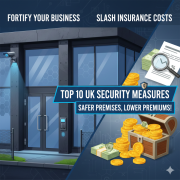The Risk Report: Top 10 Most Vulnerable Business Types in Leeds & Yorkshire
Leeds is a vibrant commercial hub, but the opportunities for business also come with heightened security risks. Latest crime statistics highlight that businesses across West Yorkshire face consistent and growing threats from theft, burglary, and robbery.
Understanding which sectors are most frequently targeted is the first step toward building an effective defense. Based on 2024 regional crime patterns, here is Kingsman Group’s report on the top 10 most vulnerable business types in Leeds and the surrounding Yorkshire areas.
The Local Threat Landscape: Why Security Matters Now
Official statistics for the year ending 2024 show an alarming trend in property crime. Leeds has consistently registered one of the UK’s highest burglary rates—nearly double the national average. Furthermore, national figures show a dramatic 54% rise in the robbery of business property, signaling that opportunistic theft is giving way to more targeted, violent crime.
For businesses in high-traffic zones like the City Centre, Armley, and the major industrial parks, a robust, integrated security strategy is essential.
Our Top 10 Most Vulnerable Business Types (2024 Trends)
The following sectors face unique vulnerabilities that criminals actively exploit, making them high-priority targets for comprehensive security solutions:
1. High-Street Retail & Convenience Stores
- Vulnerability: Constant public accessibility, high volumes of small, easily disposable items (alcohol, food, cosmetics), and significant risk of shoplifting, which remains a primary offence in Leeds.
- Solution: Discreet Manned Guards (store detectives) and advanced CCTV with facial recognition capabilities.
2. Construction Sites & Trades Depots
- Vulnerability: West Yorkshire is consistently ranked as a hotspot for tool theft from vehicles and sites. High-value building materials, copper piping, and machinery left unattended overnight pose an irresistible target.
- Solution: Out-of-hours Mobile Patrols, remote CCTV linked to a monitoring station, and rigid Access Controlfor site staff and contractors.
3. Wholesale, Storage & Industrial Units
- Vulnerability: These sites hold high-value bulk stock (electronics, clothing, specialised equipment) and are often located in industrial estates with lower nighttime foot traffic, making them susceptible to organised, planned burglaries.
- Solution: Perimeter security fencing, Void Property Services (if premises are empty), and Manned Guards at entry gates.
4. Logistics & Distribution Centres
- Vulnerability: Targeted for cargo theft, vehicle break-ins, and high turnover of external drivers. The sheer size of these premises makes comprehensive coverage challenging.
- Solution: AI-enhanced CCTV for monitoring loading docks and yard perimeters, alongside Mobile Patrols for large area coverage.
5. Licensed Premises (Pubs, Bars, Nightclubs)
- Vulnerability: High cash flow, long operating hours, and elevated risk of public order offences, violence, and targeted robbery immediately after closing time.
- Solution: SIA-licensed Manned Guards for public safety and Key Holding services for secure, immediate closing procedures and alarm response.
6. Commercial Offices with High-Value IT
- Vulnerability: Despite lower foot traffic, high-end laptops, monitors, and servers are easily sold and frequently targeted. This risk is amplified in multi-tenant buildings where access can be more complex.
- Solution: Access Control (e.g., biometrics or smart fobs) at internal and external doors, and CCTV focused on server rooms and valuable storage areas.
7. Jewellers & Specialist Electronics Stores
- Vulnerability: High-value, compact items. These businesses face the highest risk for aggressive robbery, especially given the increase in armed business property attacks noted in 2024 data.
- Solution: Comprehensive Key Holding (to reduce staff exposure during alarm events) and highly visible Manned Guarding during peak hours.
8. Unoccupied (Void) Commercial Properties
- Vulnerability: Vacant premises attract trespassing, asset stripping (e.g., copper cable theft), arson, and illegal occupation.
- Solution: Specialised Void Property Services including security screens, regular Mobile Patrols, and temporary, wireless alarm systems.
9. Educational Institutions (Schools & Colleges)
- Vulnerability: Targeted during holidays and weekends for copper, IT equipment, and vandalism. Large, sprawling campuses are difficult to secure with a single system.
- Solution: Integrated perimeter CCTV, Key Holding and Alarm Response to limit liability for staff, and proactive Mobile Patrols during non-term time.
10. Pharmacies & Chemists
- Vulnerability: Like retail, they are targeted for high-value cosmetics, but they carry the additional high risk of being targeted for prescription drugs (especially controlled substances), which requires specific security protocols.
- Solution: Reinforced physical security, strict Key Holding protocols, and CCTV covering stock rooms and dispensing areas.
Secure Your Business with an Integrated Strategy
The lesson from 2024 is clear: reliance on outdated systems or lone security measures is no longer enough. The best defense against these evolving threats is an integrated security package that combines the efficiency of technology with the reliability of human expertise.
Kingsman Group provides a complete security ecosystem for businesses across Leeds and Yorkshire:
- Manned Guarding: Professional, SIA-licensed guards for high-risk deterrence.
- Marksman CCTV Services: AI-enhanced monitoring and installation for proactive threat detection.
- Huntsman Keyholding Services: Rapid, professional alarm response 24/7, protecting your staff from exposure to risk.
Don’t wait to become another statistic. Take control of your premises security today.















